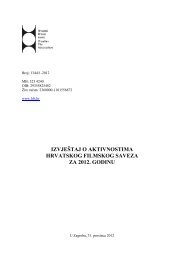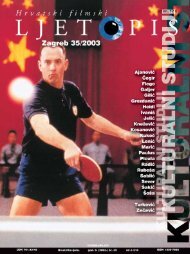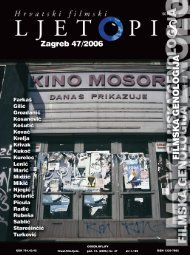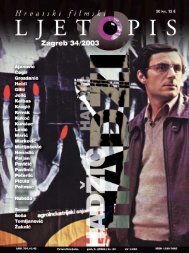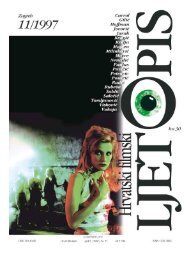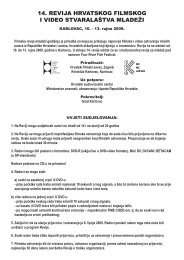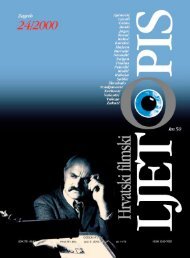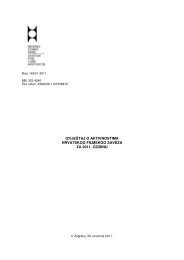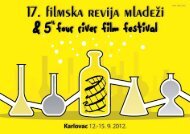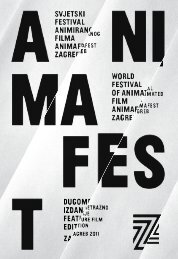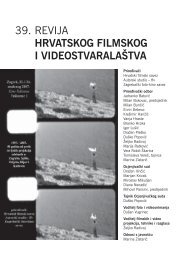Create successful ePaper yourself
Turn your PDF publications into a flip-book with our unique Google optimized e-Paper software.
hfl_<strong>53</strong>.qxp <strong>2008</strong>-04-18 11:08 Page 164<br />
Esej se osvr}e na recentni, ~etvrti film Lou Yea, kineskog redatelja tzv. {este<br />
generacije kineskih redatelja. Ljetna pala~a (Yihe yuan, 2006) je zbog<br />
prikazivanja studentskih nemira na trgu Tiananmen u Pekingu 1989., ali i<br />
zbog eksplicitnih scena seksa, svojem redatelju donio zabranu rada i sukobe<br />
s dr`avnom cenzurom. Autorica teksta razla`e strukturu Lou Yeova filma<br />
kao prikaza putovanja jedne du{e od rodnoga grada preko studentskog<br />
`ivota, koji se poklopio s revolucionarnim zbivanjima, do razo~aranja `ivotom<br />
i smrti, u vremenu od 1989. do 2003. godine, odnosno, na filmsku pri-<br />
~u kao metaforu razo~aranja jedne generacije. Teza je da se unutarnji konflikt<br />
odvija kao odraz izvanjskog, i da je izvanjska fabula prikazana u filmu<br />
(ona politi~ka) tek odraz jednog duhovnog putovanja koje se, prema Lou<br />
Yeovim rije~ima, moglo dogoditi samo na tom mjestu i u to vrijeme.<br />
164<br />
Hrvat. film. ljeto, Zagreb / god 14 (<strong>2008</strong>), br. <strong>53</strong>, str. 161 do 167 Sa`eci / Summaries<br />
Marijan Krivak<br />
Wim Wenders — ili filmski<br />
postmodernizam »tijekom vremena«<br />
UDK: 791.633-051Wenders, W.<br />
791.038.6<br />
U svojoj knjizi The Condition of Postmodernity. An Enquiry into the Origin<br />
of Cultural Change (1990) David Harvey je pomo}u analiza »vremena<br />
i prostora u postmodernom kinu« dao bitne odgovore na pitanje postmodernosti<br />
na filmu. U njegovim analizama sredi{nje mjesto zauzimaju dva filma:<br />
Blade Runner (Ridley Scott, 1982) i Nebo nad Berlinom (Der Himmel<br />
über Berlin, Wim Wenders, 1987). Wendersovu opusu odgovara tip interpretacije<br />
koja osnovom do`ivljavanja pojedinog filma ~ini svijest o recepciji,<br />
te, onda, i o manipulaciji gledateljskim o~ekivanjima i variranju `anrovskih<br />
obrazaca. Citatna polemi~nost, nagla{ena eklekti~nost, autoreferentnost,<br />
kao i upu}enost na cjelokupnu povijest filmske umjetnosti daljnja su<br />
postmodernisti~ka filmska uo~ljiva u Wendersa. Kada se isti~e »europskost«<br />
kao specifi~nost teorijskog postmodernizma »lyotardovske provenijencije«,<br />
ne smije se zanemariti ni ~injenica da je velik broj europskih filmskih autora<br />
tog usmjerenja bio zadivljen ameri~kim `anrovskim filmom i njegovim<br />
narativnim obrascima. S druge strane, populisti~ki karakter ameri~ke popart<br />
umjetnosti najprimjerenije je stjeci{te konzumeristi~ke kulture, s ~ime se<br />
postmodernizam naj~e{}e i identificira. U kontekstu navedenoga, autor<br />
~lanka tematizira Wendersove filmove kao prototipske Po-Mo filmove, koji<br />
ostvaruju specifi~an spoj ameri~ke pop-kulturne rock-ikonografije i naslije-<br />
|a njema~ke Filmverlag der Autoren. U slijedu Harveya, napose se paralelno<br />
gledaju i i{~itavaju Blade Runner i Nebo nad Berlinom kao dva pola, negativni<br />
i pozitivni, postmoderne slike ameri~ke utopije.<br />
Sre}ko Horvat<br />
Terorizam na filmu (Umri mu{ki 4.0,<br />
WTC, United 93, Rendition i druge<br />
mitologije)<br />
UDK: 323.285:791-21(73)"200"<br />
Jedan dio teksta je ulomak iz knjige Diskurs terorizma, koja ove godine<br />
izlazi u izdanju AGM-a. Putem analize novijih filmova o terorizmu, kao {to<br />
su Umri mu{ki 4.0, WTC, United 93, Rendition i drugi, autor nastoji pokazati<br />
kako se nakon 11. rujna medijski reprezentira terorizam. ^injenicu da<br />
je WTC snimljen kao film katastrofe koji po svemu nalikuje na klasi~ne filmove<br />
o potresima autor povezuje sa znamenitim potresom u Lisabonu, nude}i<br />
tako interpretaciju po kojoj se i terorizam »naturalizira« i predstavlja<br />
kao emanacija nekog onostranog i vje~nog Zla. Umjesto toga, terorizam bi<br />
trebalo shvatiti ne samo kao rezultat nekih fanati~nih skupina (a teroristi su<br />
u filmovima naj~e{}e portretirani upravo kao lu|aci koji se samo mole Alahu),<br />
ve} kao rezultat ekonomsko-dru{tvene realnosti, odnosno kao sredstvo<br />
s kojim se ne moramo slo`iti, ali koje je ovdje jer u suvremenom, zapadnom<br />
svijetu o~ito ne{to ne valja.<br />
Mia Dora Prvan<br />
Ljetna pala~a Lou Yea: unutarnji put<br />
pojedinca u politi~kom kontekstu<br />
kineske 1989.<br />
UDK: 791.633-051Lou, Y.<br />
791-21(510)"200"<br />
Marijan Krivak<br />
Wim Wenders — or film postmodernity<br />
»Im Lauf der Zeit«<br />
UDK: 791.633-051Wenders, W.<br />
791.038.6<br />
In his book The Condition of Postmodernity. An Enquiry into the Origin of<br />
Cultural Change (1990), David Harvey gave crucial answers to the question<br />
of postmodernity in film by analysing »time and space in postmodern cinema«.<br />
He focuses his analysis on two films: Blade Runner (Ridley Scott,<br />
1982) and Wings of Desire (Der Himmel über Berlin, Wim Wenders, 1987).<br />
A type of interpretation which makes the consciousness about reception<br />
and about viewers expectations' manipulation and genre patterns' variation<br />
a basis for experiencing individual films is the type of interpretation suitable<br />
for Wenders's work. Polemical citations, pronounced eclecticism, selfreference,<br />
and reference to the whole history of film are postmodernist elements<br />
that can be captured in Wenders's films. When »a European quality«<br />
is emphasized as a theoretical postmodernism specificity of »Lyotard origin«,<br />
the fact that a high number of European film authors were impressed<br />
by the American genre film and its narrative patterns can not be forgotten.<br />
On the other hand, the populist character of the American pop-art is the<br />
most adequate pool of consumer culture, with which postmodernism is<br />
most commonly identified. The author of this text analyzes Wenders's films<br />
as prototypical Po-Mo films which are a specific combination of the<br />
American pop-culture and rock-iconography and the legacy of the German<br />
Filmverlag der Autoren. Blade Runner and Der Himmel über Berlin are<br />
examined separately as two poles, the negative and the positive, of the<br />
postmodernist image of the American utopia.<br />
Sre}ko Horvat<br />
Terrorism on film (Die Hard 4.0, WTC,<br />
United 93, Rendition, and other<br />
mythologies)<br />
UDK: 323.285:791-21(73)"200"<br />
A part of the text is a paragraph from the book Discourse of Terrorism<br />
which will be published this year by AGM publishing house (Zagreb).<br />
Analyzing new films on terrorism, such as Die Hard 4.0, WTC, United 93,<br />
Rendition and others, the author is trying to show how terrorism is presented<br />
in the media after 9/11. The author uses the fact that WTC is made<br />
as a disaster film that quite resembles classical films about earthquakes and<br />
links it to a well-known Lisbon earthquake and thus gives another interpretation<br />
which both naturalizes terrorism and presents it as the emanation<br />
of some other-worldly and eternal Evil. Instead, terrorism should be understood<br />
not only as a consequence of some fanatical groups (terrorists in films<br />
are usually portrayed as lunatics praying to Allah) but as a consequence of<br />
an economic and social reality, i.e. as a tool we need to confront but that<br />
exists because there is obviously something wrong with the modern, western<br />
world.<br />
Mia Dora Prvan<br />
Lou Ye's Summer Palace: internal road<br />
of an individual in the political context<br />
of China in 1989<br />
UDK: 791.633-051Lou, Y.<br />
791-21(510)"200"<br />
The essay reviews the most recent and the fourth film by Lou Ye, a Chinese<br />
director of the so-called sixth generation of Chinese directors. Summer<br />
Palace (Yihe yuan, 2006) presents student protests on Tiananmen Square in<br />
Beijing in 1989 and also some explicit sex scenes, which is why the director<br />
was prohibited from work and had conflicts with state censorship. The<br />
author of this text examines the structure of Lou Ye's film as a depiction of<br />
a journey of a soul from the home town and student life, which coincided<br />
with revolutionary events, to disappointment and death, from 1989 to<br />
2003. The author examines the story as a metaphor of generation's disappointment.<br />
The thesis is that the internal conflict is a reflection of the external<br />
one, and that the external plot (the political part) is presented in the<br />
film as only a reflection of a spiritual journey which, according to Lou Ye,<br />
could only happen at that time on that place.<br />
H R V A T S K I F I L M S K I L J E T O P I S <strong>53</strong>/<strong>2008</strong>.



